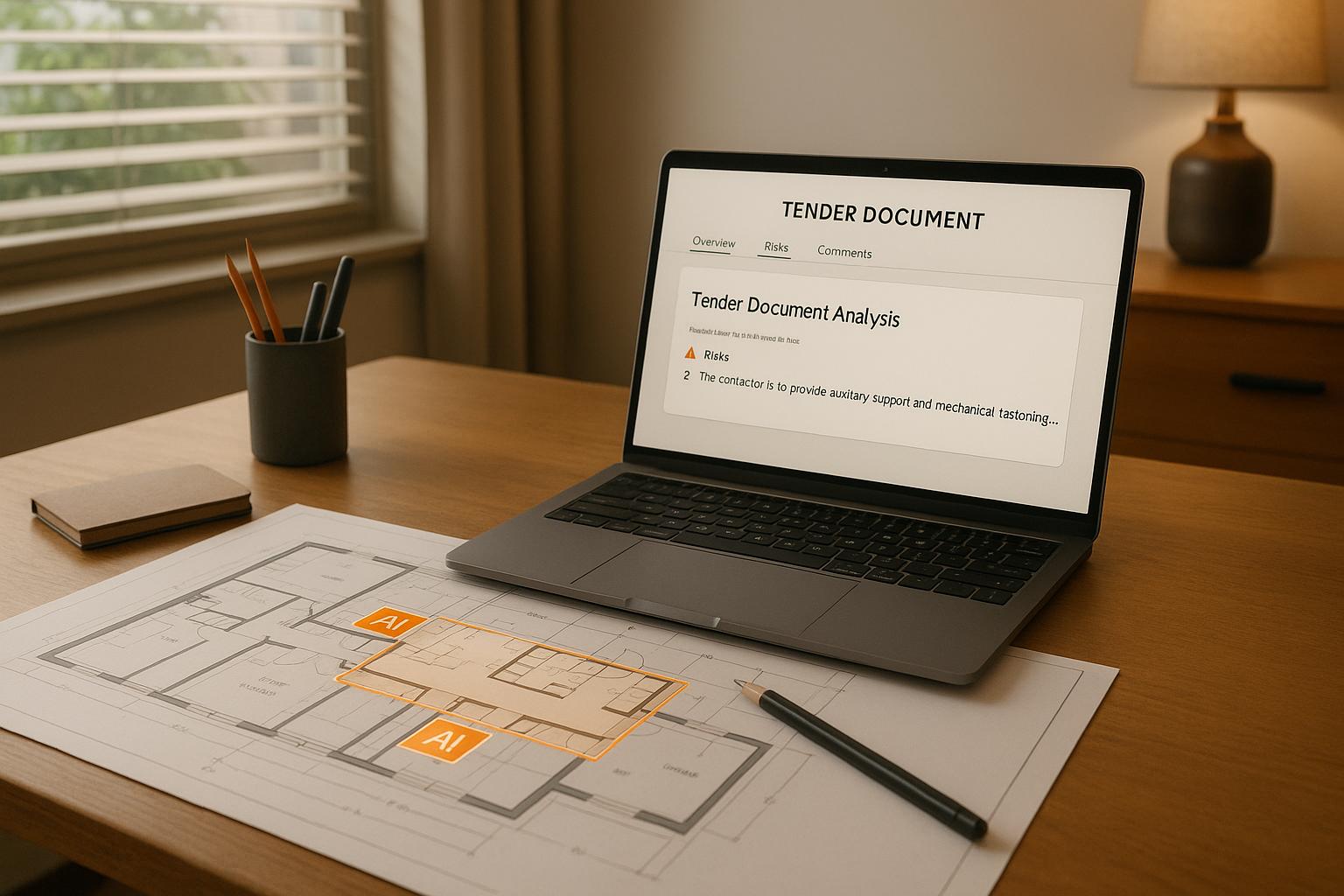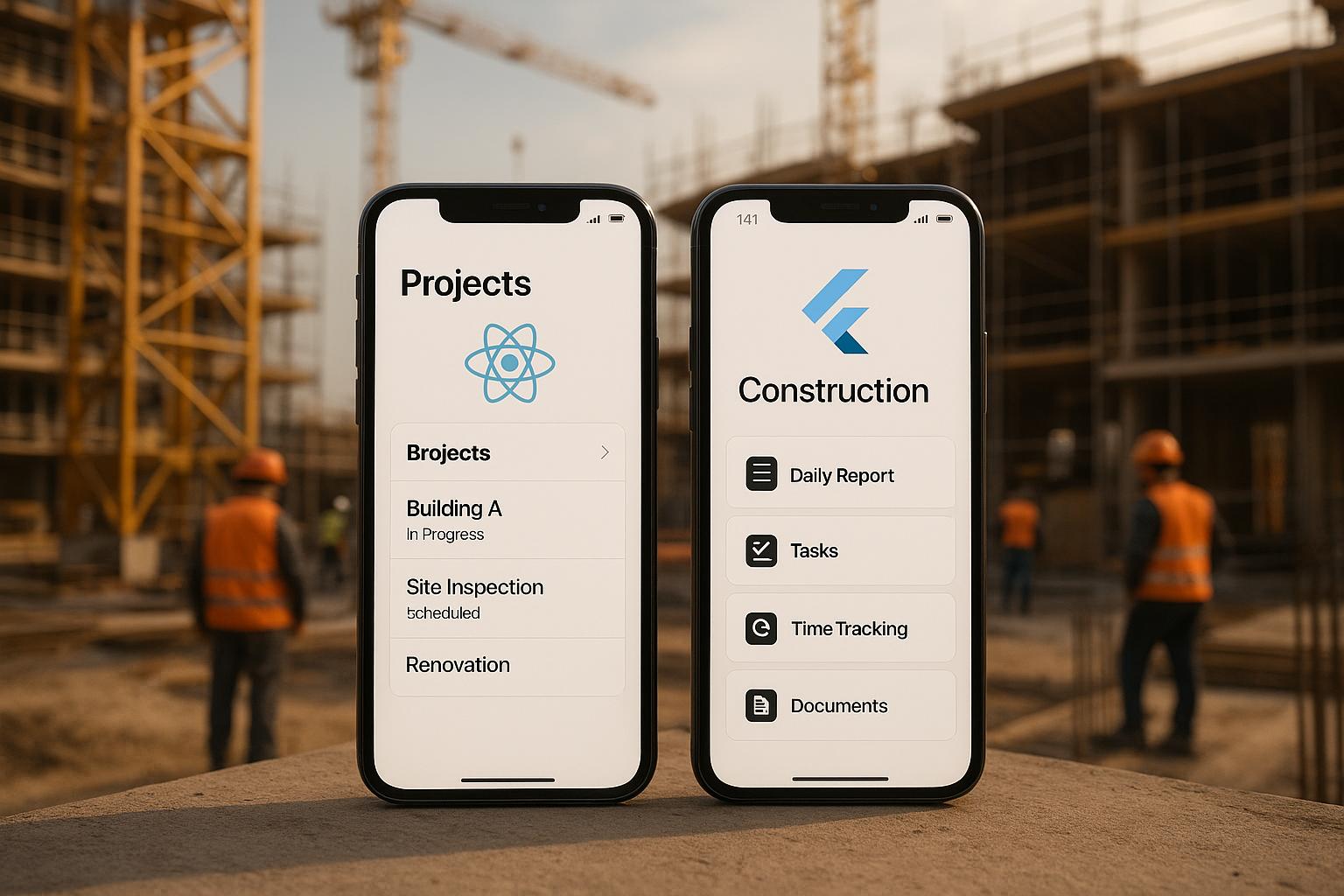AI for Tender Reviews: How to Let Models Catch Scope Gaps Before Your Engineers Do
Taher Pardawala November 21, 2025
Missed scope gaps in tenders can cost you – up to $330,000 on a $100M project. AI tools can help prevent this by analyzing tender documents faster and more accurately than manual reviews. Using technologies like OCR, NLP, and machine learning, these systems identify missing details, flag inconsistencies, and prioritize risks. This saves time, reduces errors, and allows engineering teams to focus on critical issues instead of combing through hundreds of pages.
Here’s how AI improves tender reviews:
- Faster analysis: Cuts review time by up to 80%.
- Risk prioritization: Assigns scores to detected gaps for focused attention.
- Improved accuracy: Predicts costs with up to 97% precision.
- Streamlined workflows: Integrates with existing tools for seamless use.
RFQ and Tender Management – Powered by AI
Why Scope Gaps Create Major Problems
The consequences of scope gaps highlight the growing need for AI-driven tender reviews. These gaps can wreak havoc on project budgets and schedules. When they go unnoticed during tender reviews, they trigger a cascade of issues that demand a more proactive and automated approach.
Scope gaps or coordination errors typically account for about 0.33% of the total contract value. For a $100 million contract, that’s a staggering $330,000 in potential profit loss if these gaps aren’t caught early [5].
"Scope gaps between vendor proposals and project requirements can quietly derail timelines and inflate costs." – Datagrid Team [1]
When left undetected, scope gaps lead to expensive change orders. Tasks that should have been included in the original scope suddenly become additional work, often requiring premium pricing [1][2][3]. These unexpected changes don’t just inflate costs – they also disrupt schedules, forcing teams to scramble for unplanned resources.
Rework becomes unavoidable when scope gaps are discovered mid-project. This eats up extra time, labor, and materials that weren’t budgeted for [1]. Projects that initially seemed profitable can quickly spiral into financial losses once missing requirements come to light.
Problems with Manual Tender Reviews
Manual tender reviews often struggle to catch every detail, especially when time is tight. Modern tender documents are massive, often running hundreds of pages filled with intricate technical specifications. Reviewing such documents manually makes it easy to miss critical elements.
Detecting scope gaps manually can consume a significant portion of the pre-construction phase, delaying project kickoffs and increasing the likelihood of errors [1]. In high-pressure environments, where multiple tenders are reviewed simultaneously, divided attention further increases the risk of overlooking vital scope elements. Add to this the mental fatigue from extended manual effort, and the potential for missed details grows even larger.
Case Study: The Fallout of Missed Scope Gaps
A real-world example shows just how damaging missed scope gaps can be. Overlooking compliance gaps often leads to costly delays before materials even arrive on-site [4]. These delays can cascade, pushing back timelines and creating scheduling conflicts that demand expensive resource reallocations.
"Missed gaps often lead to scope creep, delays, and surprise costs that directly hit your timeline and efficiency." – Datagrid Team [1]
When scope gaps surface during execution, disputes between stakeholders are almost inevitable. Clients may expect deliverables that weren’t clearly defined, while vendors argue that the work falls outside their contractual obligations. This friction can lead to a surge in Requests for Information (RFIs), creating administrative bottlenecks that slow projects down [1][2]. In extreme cases, these disagreements escalate into legal disputes, damaging business relationships.
Quality often takes a hit as teams rush to implement quick fixes to stay on schedule. Unforeseen work stemming from undetected scope gaps frequently leads to schedule disruptions and compromises in quality [2].
The aftermath? Teams are left grappling with cost overruns, delays, quality issues, and strained stakeholder relationships – problems that could have been avoided with a thorough review during the tender phase.
How AI Finds Scope Gaps in Tender Documents
AI-powered tools are transforming how tender documents are reviewed, using advanced technologies like OCR, NLP, and machine learning to streamline the process. These systems can cut evaluation times by as much as 80% [6], ensuring that even the smallest details don’t slip through the cracks.
Companies leveraging AI in tendering are seeing impressive results. They’re able to pursue up to three times more opportunities and earn a fivefold return on investment [6] by processing large volumes of information with speed and precision.
Core Technologies: OCR, NLP, and Machine Learning
Optical Character Recognition (OCR) is the starting point for AI in tender analysis. It converts documents – whether they’re PDFs, scanned files, emails, or spreadsheets – into machine-readable text. This structured data becomes the foundation for further analysis [1].
Natural Language Processing (NLP) takes it a step further by analyzing unstructured text. It identifies critical elements like key clauses, compliance requirements, and technical details with remarkable accuracy [1][7].
Machine Learning (ML) algorithms then compare the extracted information against the requirements laid out in Request for Proposal (RFP) documents. These algorithms are adept at spotting discrepancies, missing details, or misalignments that human reviewers might overlook [1].
When combined, these technologies deliver impressive results. They can predict costs with up to 97% accuracy and cut estimation times in half [7]. This level of precision and efficiency is a game-changer compared to traditional manual review methods.
How AI Flags Scope Gaps
AI systems analyze tender documents using advanced pattern recognition techniques to identify potential problem areas. By cross-referencing every RFP requirement with vendor proposals, these systems flag discrepancies that require attention.
To prioritize issues, AI assigns risk scores to the gaps it identifies. This ensures that teams can focus their efforts on the most critical concerns [1]. Additionally, AI can automatically generate pre-bid queries to address ambiguities or unclear requirements, allowing teams to proactively seek clarification [6]. Tackling these issues early in the bidding process helps prevent complications once the contract is awarded.
This level of automation has real financial benefits. It has been shown to reduce potential revenue losses by about 9% caused by human errors [6]. Moreover, data indicates that AI can boost bid success rates by 20% [7], helping teams submit more precise and comprehensive proposals.
Step-by-Step Process for AI-Driven Tender Reviews
AI-driven tender reviews simplify the process of identifying scope gaps quickly and accurately. This structured approach ensures potential issues are flagged early while maintaining the level of precision required by engineering teams. Here’s how the process works, from uploading documents to the final engineering review.
1. Document Upload and Setup
Start by centralizing all tender documents in digital form – whether they’re PDFs, Word files, Excel sheets, or scanned images. Organizing these files into a clear, standardized folder structure aligned with your project requirements is crucial. For example, you might separate technical specifications from commercial terms into distinct folders to allow the AI to apply the correct analysis to each type.
Using consistent file naming and organization improves OCR (optical character recognition) accuracy and ensures proper categorization. Once the documents are set up, define evaluation parameters, such as key terms, compliance standards, and success criteria. Standardized templates can help ensure no critical elements are missed during the review, regardless of who is conducting it.
2. Automated Gap Detection and Reports
After processing the documents, AI cross-references project requirements with vendor proposals to identify discrepancies. The system generates detailed reports pointing out missing details or areas where vendor responses fall short of project expectations.
These reports also include risk scores, helping teams prioritize critical issues. For instance, missing safety certifications or incomplete technical data may be flagged as high-risk items requiring immediate attention.
Key outputs from this step include:
- Executive summaries for leadership, offering high-level overviews.
- Detailed technical analyses for engineering teams to dive into specifics.
- Compliance checklists to ensure regulatory standards are met.
Real-time reporting ensures teams receive preliminary findings shortly after uploading documents. Visual dashboards often accompany these reports, featuring color-coded indicators to highlight compliance levels, tender quality, and risk areas. This makes it easy to spot proposals needing closer inspection versus those that are nearly ready for approval.
3. Team Review with Engineering Input
The final stage blends AI-generated insights with human expertise. Engineers review flagged items, using the AI’s contextual details to focus on more complex evaluations. This collaborative approach allows teams to handle routine gaps through AI recommendations while reserving their expertise for nuanced decisions.
The AI system’s ability to pinpoint specific sections of documents and provide context streamlines these reviews, making them faster and more thorough than traditional manual methods. Straightforward recommendations can often be accepted directly, while more intricate issues are flagged for deeper analysis.
The process concludes with a consolidated report that combines AI findings with engineering assessments. This final output provides actionable recommendations for vendor selection, contract negotiations, and strategies to mitigate risks effectively.
sbb-itb-51b9a02
What to Look for in AI Tender Review Tools
Picking the right AI tender review tool can make a huge difference in identifying scope gaps early and avoiding expensive mistakes. The most effective tools pair automation with seamless integration into your existing workflows, allowing teams to work faster while maintaining accuracy. Here’s what to focus on when evaluating these tools.
Automated Bid Comparison and Scope Analysis
Top-tier AI tools excel at side-by-side bid comparisons, automatically spotting differences in vendor proposals across key areas like technical specs, pricing, and timelines. These comparisons are presented in clear, actionable formats, making it easier for teams to identify discrepancies.
When it comes to scope analysis, the best tools go beyond basic keyword matching. They leverage natural language processing (NLP) to understand context and flag inconsistencies in how vendors interpret requirements. For example, if one vendor proposes "standard steel reinforcement" while another specifies "Grade 60 rebar with epoxy coating", the AI should recognize this as a potential variance that needs clarification. This type of analysis is essential for efficient and thorough tender reviews.
Real-Time Alerts and Notifications
Speed matters during tender reviews, and real-time alerts can keep your team ahead of potential issues. The best tools notify team members as soon as critical problems are detected, rather than waiting for the entire document to be processed.
These notification systems can be tailored to deliver the right information to the right people. For example, project managers might get concise risk summaries, while engineers receive more detailed technical reports. Customizable alert thresholds ensure that only significant issues trigger notifications, reducing unnecessary distractions.
Alerts are sent through various channels – push notifications, emails, or mobile updates – allowing decision-makers to stay informed and take action, even when they’re not at their desks.
Integration with Current Workflows
Integration is key to ensuring that AI insights fit smoothly into your team’s existing tender review process. The best tools connect directly with document management systems, project management software, and communication platforms via APIs or specialized add-ins.
By integrating with document management systems, these tools help maintain up-to-date files and audit trails, reducing the risk of reviewing outdated documents or missing last-minute vendor updates. This continuity is especially important as tender reviews transition into project execution, ensuring critical details aren’t lost during handoffs between procurement and delivery teams.
Additionally, the most effective tools tap into knowledge bases and historical project data, offering insights from past reviews to inform current evaluations. Solutions that work within familiar environments, like Microsoft Office add-ins or existing collaboration platforms, tend to be adopted more widely and consistently by engineering teams, making them a practical choice for long-term use.
Best Practices for Adding AI to Tender Reviews
Introducing AI into tender review processes should be a gradual and deliberate effort. Starting small and balancing automation with human expertise can help refine workflows and build trust in the technology. Here’s how to integrate AI effectively while maintaining expert oversight.
Start Small with Pilot Projects
Kick off with pilot projects that focus on moderately complex tenders with lower stakes. These initial tests allow you to see how AI handles different document formats and identify common false positives. Track key metrics like analysis time, gap detection accuracy, and team feedback to establish a baseline for performance. It’s worth noting that AI tends to perform differently depending on the type of tender or industry, so results may vary.
Once you’ve demonstrated success on a smaller scale, gradually expand to other departments or project types. This step-by-step approach provides room to fine-tune workflows and AI training before rolling it out across the organization.
Pair AI Insights with Expert Review
AI can flag potential issues, but expert judgment remains critical. Use human oversight to verify gaps identified by AI, distinguishing between genuine discrepancies and standard industry practices. Create feedback loops where engineers document why certain flags are dismissed, allowing the AI to improve over time. Focus on high-confidence detections for immediate review, while lower-confidence items can be addressed later. This method enhances efficiency without compromising the quality of decisions.
Train Teams to Interpret AI Results
Equip your teams with the skills to understand and act on AI-generated reports. Standardize workflows for reviewing flagged items, and set clear expectations for response times based on the level of risk. Regular training sessions should focus on practical applications, ensuring everyone – from procurement staff to engineers – understands how to interpret classifications and confidence scores.
Rather than diving into the technical details of machine learning, emphasize actionable insights. For example, teach engineers how to assess scope gap classifications, when to prioritize based on AI confidence levels, and how to spot patterns that might indicate incomplete analysis. The goal is to make AI insights actionable and improve collaboration across teams without overwhelming them with technical jargon.
Conclusion: How AI Changes Tender Reviews
AI is reshaping how tender reviews are conducted by identifying scope gaps early in the process, saving time, and reducing the risk of budget overruns. This shift moves teams from reacting to problems after they arise to addressing potential risks upfront.
One of AI’s strengths lies in its ability to significantly cut down analysis time while maintaining consistency in detecting gaps – something that human reviews can sometimes miss. It also standardizes the review process, regardless of project size, and excels at cross-referencing multiple documents to uncover inconsistencies, which is especially crucial as tender documents become more intricate and involve numerous stakeholders.
By automating routine review tasks, AI frees up teams to focus their expertise where it’s needed most. This not only makes the process more efficient but also boosts confidence in the initial evaluations conducted by procurement teams. Instead of replacing human expertise, AI complements it, creating a workflow where technology handles document analysis, and experts make the final decisions. This balance ensures quality and builds trust in the system.
As AI technology continues to evolve, tender reviews will become even more precise and efficient. Organizations that embrace these tools now will be better equipped to manage larger, more complex projects while avoiding costly mistakes. By integrating AI into their review processes, teams can minimize risks and achieve accurate, reliable results.
FAQs
How does AI enhance the accuracy of tender reviews compared to manual processes?
AI plays a crucial role in improving tender reviews by swiftly spotting missing details or inconsistencies in project scopes. This early detection helps prevent potential gaps that could lead to expensive mistakes or rework later during project execution.
Unlike traditional manual reviews, AI tools can analyze large volumes of tender documents in a fraction of the time. This ensures that no critical information slips through the cracks. By automating this process, engineering teams can dedicate more time to strategic tasks, boosting both efficiency and the quality of decision-making.
What technologies power AI-based tender reviews, and how do they help identify scope gaps?
AI-driven tender reviews bring together cutting-edge technologies to quickly and effectively identify scope gaps. Here’s how it works:
- AI-powered document processing converts various file formats into structured data, making it ready for analysis without manual effort.
- Natural Language Processing (NLP) dives into unstructured text, extracting and interpreting key details that could otherwise be overlooked.
- Machine learning algorithms step in to compare the extracted data against project requirements, flagging any missing or misaligned elements.
- Risk scoring systems evaluate and rank these gaps, ensuring teams can tackle the most critical issues first.
This seamless collaboration of technologies not only speeds up the tender review process but also minimizes the chances of costly mistakes.
How can businesses effectively use AI to streamline tender reviews and identify scope gaps early?
Businesses can enhance their tender review processes by using AI tools designed to handle essential tasks like data extraction, identifying scope gaps, and predictive analytics. These AI-powered features ensure that tender documents are analyzed in detail, helping to reduce the chances of overlooking important requirements or mismatches with project objectives.
Integrating AI solutions into the workflow not only saves time but also reduces human error and supports better decision-making. These tools can blend smoothly with current processes, allowing for quicker evaluations and more precise assessments of project scopes. The result? A more efficient and reliable tender review process.
Related Blog Posts
- How AEC Startups Can Leverage AI for Better Project Estimation
- AI-Powered Estimation: How Machine Learning is Transforming Construction Bidding
- AI-Powered Quality Control: How Computer Vision is Revolutionizing Construction Inspections
- 10 AI Prompts Every Construction PM Should Use to Clean Up Project Chaos (With Copy-Paste Examples)








Leave a Reply